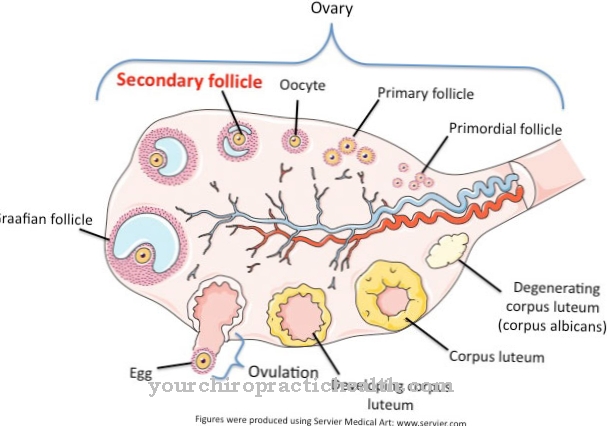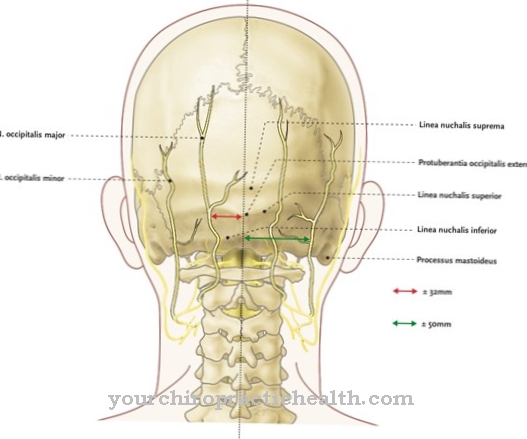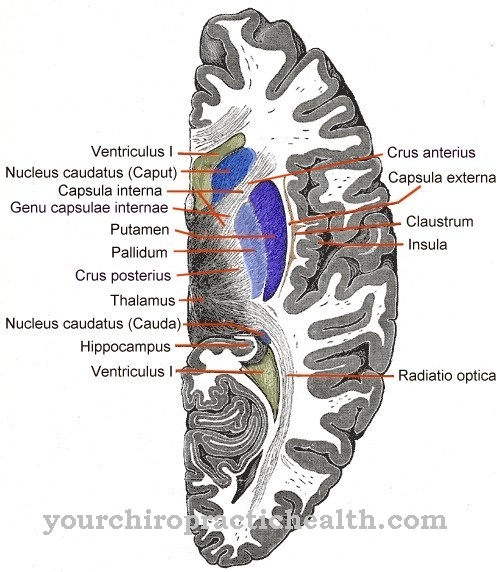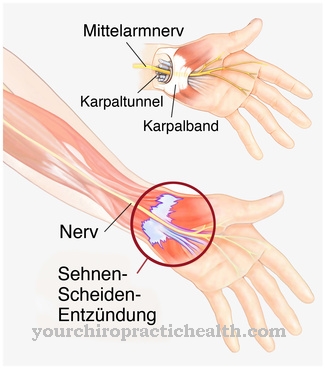Muscle spindles are sensory organs that belong to the group of proprioceptors and recognize the state of stretching and the change in stretching of the skeletal muscles and deliver the generated signals to fast, afferent Ia nerve fibers. Muscle spindles also have efferent nerve connections that control their sensitivity. The muscle spindles also serve to control the muscle length and the associated muscle contractions via the gamma spindle loop.
What is a muscle spindle?
Muscle spindles, in their capacity as sensors for the state of strain of the skeletal muscles, belong to the group of proprioceptors, with the help of which a position picture of the position of individual limbs and the body is created in the corresponding brain centers.
At the same time, the situation map and the muscle spindles are used to control conscious and unconscious movements - also to control muscle reflexes. As sensors, muscle spindles have proportional and differential properties. This means that they record both the static stretching states of individual muscles and the dynamic rate of change in their stretching and transmit them via afferent Ia nerve fibers, which have the highest conduction speed in the human body.
The frequency distribution of muscle spindles in the individual skeletal muscles provides a measure of the fine or gross motor control possibilities of the muscle. For example, the quadriceps (quadriceps femoris muscle), which attaches to the front of the thigh as a leg extensor, has 500 to 1,000 muscle spindles. They are embedded between the muscle fibers of the skeletal muscles, parallel to the orientation of the muscle fibers and reach a length of 1 to 3 millimeters.
Anatomy & structure
The core of the muscle spindles is a bundle of five to ten striated intrafusal muscle fibers and are encased in a connective tissue sheath. Intrafusal muscle fibers are found exclusively in muscle spindles.
Their peculiarity is that they are contractile, i.e. active, at their ends, while their middle part is stretchable and passively adapts to the stretching state of the skeletal muscle. The passive middle part of the muscle spindles consists of core sac fibers and core chain fibers. When the muscle contracts, the muscle spindle also shortens. The core sac fibers bulge out a little so that the central part of the muscle spindle thickens. To record the change dynamics, the core sac fibers are wrapped exclusively in fast-conducting, afferent Ia nerve fibers that react to any change in thickness.
The core chain fibers, which detect the rather static stretching state of the muscle, are also connected to Ia nerve fibers, but also as a secondary innervation with afferent fibers of class II. Class II fibers are less sensitive and conduct impulses more slowly than Ia fibers . The two contractile end sections of the intrafusal muscle fibers are connected to efferent gamma neurons, which control the sensitivity of the muscle spindles and the target muscle contraction.
Function & tasks
Muscle spindles simultaneously fulfill several tasks and functions for the coordination of gross and fine motor movements, for establishing and maintaining static positions and for protecting the individual skeletal muscles from overstretching. Muscle spindles are therefore part of a complex control and regulation system.
For a coordinated sequence of movements, it is necessary that certain muscles each assume a given static stretch state or follow a given dynamic change in the stretch state. The motor centers of the brain can perform these tasks because the muscle spindles simultaneously perform the passive function of a sensor and the active role of a target value for the muscle. Via the contractile end pieces of the intrafusal muscle fibers, the muscle spindles can follow the respective stretch state of the muscles and be adapted or they can also generate the target value for the muscle. The length of the muscle is changed by appropriate contraction commands in such a way that a 0 potential is created in relation to the muscle spindle.
In this case, the muscle adapts to the muscle spindle and not the other way around. To fulfill their protective function against overstretching the muscles, muscle spindles take over the control of involuntary stretching reflexes. As soon as the stretch condition of a muscle exceeds a certain threshold value, which is detected by the muscle spindles, this triggers an involuntary contraction signal to the muscle in question, which is also controlled via the muscle spindles.
A typical example of such a contraction reflex is the patellar tendon reflex. A brief blow with the reflex hammer on the patellar tendon below the kneecap briefly signals an overstretching of the quadriceps, which leads to a contraction reflex, as the lower leg makes an involuntary twitch in the direction of the leg extension.
You can find your medication here
➔ Medicines for muscle weaknessDiseases
Independent morphological diseases that explicitly affect muscle spindles are not known. This is probably due to the fact that the muscle spindles are specialized muscle fibers that are more likely to follow diseases of the muscles in which they are embedded. First and foremost, muscular atrophies should be mentioned, which are caused by underuse of the muscles.
The corresponding muscle recedes as a result of the reduced stress and, in parallel, the muscle spindles as well. Muscle atrophy is often caused by nervous disorders or by damage to the corresponding motor neurons, from which the muscle can no longer receive impulses. Amyotrophic lateral sclerosis (ALS) is an example of neurogenically induced muscular atrophy. It is an incurable degenerative disease of the motor nervous system. Another rarely occurring disease is spinal muscular atrophy, which is caused by a gradual deterioration of motor nerves in the anterior horn of the spinal cord.
A number of diseases that lead to changes in the motor end plates in the intrafusal muscle fibers of the muscle spindles can also be traced back to neurological disorders and diseases. There is a cross-link between the fight against Alzheimer's and the functioning of the muscle spindles.
A research group in Berlin has found that the enzyme beta-secretase, which is held responsible for the harmful protein deposits in Alzheimer's disease, is obviously important for the functionality of the muscle spindles, so that suppressing the enzyme in Alzheimer's patients is likely to cause coordination disorders in the movement sequence would.

.jpg)











.jpg)

.jpg)
.jpg)











.jpg)